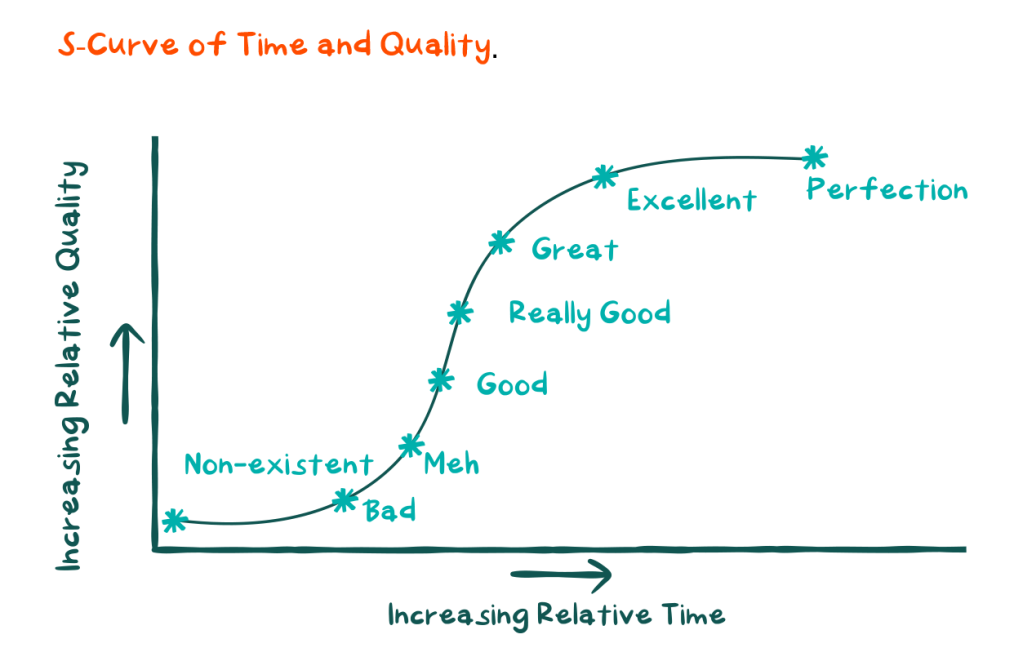Doing the Best You Can With the Time You Have
These strategies can help overwhelmed teachers prioritize tasks and find a balance between perfectionism and efficiency.
Your content has been saved!
Go to My Saved Content.The first two years are especially challenging for new educators who are perfectionists, and I have to say it doesn’t get much easier for veterans with that tendency. Rookie or not, you are going to have to be at least comfortable with some things being “good enough for now.” To that end, I share the “S-curve of time and quality.”

As a newer teacher, you need to recognize that there’s no way to alter the space-time continuum. You will never have enough relative time to improve the quality of all the tasks on your plate from “nonexistent” to “perfection,” and that’s OK. Hopefully, for some tasks you are already somewhere in the “good” to “great” range, and you and your students can enjoy those as is or put in just a bit more time to get them to the next level. Perhaps your school uses a curriculum that needs only a little fine-tuning, or you’re on a team that has resources they are happy to share.
On the other hand, you may be building everything from scratch, so nearly everything is starting at the “nonexistent” end of the “relative quality” axis. The time to get things to just “good” may be twice as long as turning something from “good” to “great.” If you have perfectionist tendencies, that “good” may seem like failure, but you may have to live with it for a little while, because if you put in as much time as it takes to get that one task to “perfection,” you may have three or four other important things that are still sitting in that “nonexistent” stage, and that is a problem.
Am I suggesting that you settle for mediocrity? Absolutely not! By all means, make things the best you can with the time you have—and make them better the next time.
What might this look like?
Problem: You want to make a review Kahoot for a unit test that you also have to write. Which one is more important to fit with what and how you have taught? Probably the test.
Solution: Find a Kahoot that already exists that is close to what you want for review and tweak it a little if you have time or give clarification while you are playing it, and spend your limited time crafting the test. Next time you do this unit, you have the makings of the test and then can create a better Kahoot or other review if needed.
Problem: You want to create a podcast assignment but have no experience doing this. In addition to its being very time-consuming, trying to do it on your own the first time will result in your missing lots of pieces that may send the assignment off the rails.
Solution: Find a colleague who has done one, even in a different subject, and tweak it to fit your needs; or find one on Teachers Pay Teachers. Use that this year, and make notes about how you want to improve it and do so next year.
Problem: You want to do a choice project at the end of a unit. You would like to have a lot of options and want to have the rubric/scoring/success criteria for each option when the students start on the project.
Solution: You have a rubric that can be used from your previous podcast project, so that can be an option. You have a rubric from a previous “create an artistic interpretation” option you gave before. And you have time to create one for a personal-reflection narrative approach.
That gives your students three options already. If you can imagine a couple of others but do not have the time to develop them, give students the opportunity to pursue an additional approach. Before their option is approved, however, they need to come up with their own rubric using the other three as models. You can also establish the option approach as an expectation that their idea and rubric may be used for future classes.
Each of these examples reinforces the continuous experience for teachers throughout their careers that creating is incredibly time-consuming, but tweaking is much less so.
Additionally, simply as a fact of gaining experience from lesson planning, creating and scoring assessments, communicating with students and parents, and so much more, you will become more efficient over time, especially if you’re open to learning from others about how they shorten that relative time axis for any given task. That means you’ll get closer and closer to that “perfection” you crave in the future in less and less time.
If this has helped you turn inward and created an “aha!” moment for yourself, take a moment to turn outward and think about this concept for your students as well. Many of them also have perfectionist tendencies, and they have no more power than you do over that space-time continuum. Their absolute best may not always be possible, but you can still be compassionate about helping them do the best they can with the time they have for any given task in your class.
Finally, more often than not, for many teachers, “really good” is actually pretty outstanding because we tend to be hard on ourselves. Read that again, frequently: “For many teachers, ‘really good’ is actually pretty outstanding!” Keep up the “really good” outstanding work with the time you have, and leave some time for the rest of your life.
